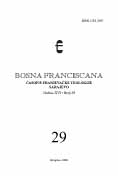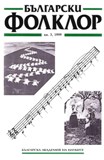



Keywords: God; curious science; techno-sphere; mutilation of the soul; belief; identity; dialogue; peace; salvation
More...
![Todor Dzidzev. Balgarskata koledna pesen v teoretichen i sravnitelen plan [Bulgarian Carol Song in Theoretical and in Comparative Perspective]. Sofia:](/api/image/getissuecoverimage?id=picture_1999_16076.jpg)



![In memoriam [Mariela Hristova]](/api/image/getissuecoverimage?id=picture_1999_16076.jpg)

The author presents her detailed analysis of the folk taxonomy denoting voice movements in polyphonic singing. She advocates that the taxonomy under consideration introduces spatial and bodily codes. In addition she argues that they are to be understood as functionally predetermined, as well as reliant on ornamentation behavior and on the involvement of the components in polyphonic singing with one another. Thus the terms express and decode movements of musical “collective body” as a whole built out of functionally differing elements. Comparing collective monodic and polyphonic singing, the article raises the hypothesis of their similarity as based on spatial ritual technology. Archaic techniques found in polyphonic singing are reported to be initial points in decoding the principles of both monodic and polyphonic singing. The author also manages to differentiate the following movements in the polyphonic structure: meandering, circling, spiral movements. All that safely brings her to the conclusion that musical components, and especially sound height, contain archaic ideas coming from rituals and myth. Monodia and collective dances bare lively traces from the simplest, clearest and oldest mythological ideas.
More...![Dimitrina Kaufman. Misteriyata na balgarskoto mnogoglasie [The Mystery of the Bulgarian Polyphonic Singing]. Plovdiv, 1998](/api/image/getissuecoverimage?id=picture_1999_16076.jpg)


The article investigates similarities and differences in various understandings of the term makam. Its uses and explanations attributed to folk singers and music players, authors and performers of ethnopop songs, as well as of Roma musicians are advocated to differ substantially from the high culture ones and are assumed to be endowed with meanings relevant to melody and interpretation rather than to being informed by structural peculiarities of makams. Thus folk singers and musicians use the word makam to mark specific mode organization, as well as a particular way of performing, while ethnopop singers tend to claim that it reveals Balkan or Oriental features together with a definite style and manner of interpretation, and Roma musicians understand makam as meaning “sweet music”, quality of performing capable of expressing the deepest feelings of the performer in sounds. Thus, the grassroot professional discourse about makam is affirmed to be characterized by only a background notion of makam’s structural peculiarities and as putting the accent on its comprehension as a characteristic feature of the musician and his audience and of their deepest perceptions and feelings.
More...
Bulgarian military songs started to appear in the 19th c., in the period of National Liberation. Bulgarian volunteers, preparing themselves in Kishineu to serve on Russian military service during the Russian-Turkish war, still in 1877 sung “Shumi Maritza” and other soldat songs, and continued to sing them during the war itself. Precisely at those times the marching step and the marching songs accompanying it, were used for the first time by the Bulgarians. All that resulted in the early Bulgarian songs being marching ones. At the very beginning Bulgarian military troops used to sing well known folk songs (mainly folk dance ones) in a marching rhythm. Gradually there appeared true marching songs, whose texts were written mostly by military officers. Their melodies were more often than not plagiarized from urban song ones, and only exceptionally created by musicians on military service. Among the latter there should specially be mentioned Alexandar Morfov, whose military songs written in the beginning of 20th c. (Niy shte pobedim, Izgrey zora na svobodata, etc.) are already real marches sung even today by the Bulgarian military troops as both their texts and their sounds are tightly connected with the soldiers’ activities and with the army life. Bulgarian poets and composers joined later their efforts in creating military marches. Especially during the war periods (1912-1913 and 1914-1918) they wrote masterpieces like Velik e nashiat voinik, Bdintzi, Bulairski marsh which are still in use in the army. There were created military songs and marches in the next decades, too. Especially productive was the second half of the 20th c. with its marches written in broader forms, sophisticated musical facture (or at least such in comparison with the older marches), but they did not gain the acknowledgement and the popularity of the older ones created in the first decades of the 20th c.
More...
The article is an attempt to experiment with yet another and very unusual point of view to the style of folk dancing. It focuses itself on a single dance and characterizes its structure, movements and presentation, but also its semantic aspects. The links between the ritual and the nonritual dances are obvious and could easily be discovered on structural level within the dances coming from a particular region. Thus there would naturally follow a question in regards to the nature of the mentioned above links and especially if they are or they are not resulting from the use of a common dancing motif stock or are also the result of some semantic interrelations. Until recently traditional Bulgarian music and dancing styles were predominantly investigated on the level of their regional variants reporting differences in outlook. An attempt has been undertaken here to gain an inward oriented description of the processes of regional style creation, as well as to explain it as reliant on the basic mechanisms of interdependence between ritual and dance. Thus, a special model of style investigation is offered. It allows for the adequate description and analysis of sitnata po stareshki, a dance which is to be considered not only the most widely spread one in Northeastern Bulgaria, but which is advocated to be representative for the whole of the region under consideration. Following the semantics of staro (old) and sitno (tiny, fine, elaborate), there are offered the following conclusions: I) Basic style characteristics are formed due to emancipation of the elements from their ritual contexts and meanings. Due to overpassing the boundaries of their ritual predetermination and meanings, the elements turned to be a stylistic mark, rather than being directly connected to their original content in the ritual context of the classical traditional culture. Thus, they are no longer sacred. 2) Nevertheless, their new standing is still deeply rooted in their former sacral meanings and function and. Thus, it is especially the latter which predetermines their high, ideal status in the new aesthetic conception, taking into consideration their old ritual importance and significance.
More...![In memoriam [Todor V. Todorov]](/api/image/getissuecoverimage?id=picture_1999_16076.jpg)

Ambassador Selim Yenel, leader of the Permanent Delegation of Turkey to the EU, recently defended Turkey’s interests in the EU during several meetings at the European Parliament, allowing Balkanalysis.com contributor Maria-Antoaneta Neag the opportunity to survey the ambassador on the latest developments in the EU-Turkey dialogue, as well as Turkey’s enhanced role in regional security.
More...Irland hat den Vertrag von Lissabon abgelehnt. Mehr als sechs Jahre nach Ausrufung des Verfassungsprozesses steht die Europäische Union vor dem Trümmerhaufen ihrer Bemühungen. Effektiver und demokratischer sollte die Gemeinschaft werden. Geblieben ist allein Ratlosigkeit. Welche Möglichkeiten bleiben der europäischen Politik?
More...